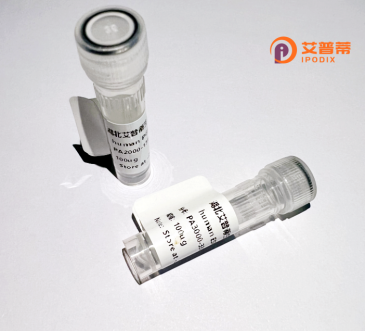
| 纯度 | >90%SDS-PAGE. |
| 种属 | Human |
| 靶点 | KPTN |
| Uniprot No | Q9Y664 |
| 内毒素 | < 0.01EU/μg |
| 表达宿主 | E.coli |
| 表达区间 | 1-436aa |
| 活性数据 | MMGEAAVAAGPCPLREDSFTRFSSQSNVYGLAGGAGGRGELLAATLKGKVLGFRYQDLRQKIRPVAKELQFNYIPVDAEIVSIDTFNKSPPKRGLVVGITFIKDSGDKGSPFLNIYCDYEPGSEYNLDSIAQSCLNLELQFTPFQLCHAEVQVGDQLETVFLLSGNDPAIHLYKENEGLHQFEEQPVENLFPELTNLTSSVLWLDVHNFPGTSRRLSALGCQSGYVRVAHVDQRSREVLQMWSVLQDGPISRVIVFSLSAAKETKDRPLQDEYSVLVASMLEPAVVYRDLLNRGLEDQLLLPGSDQFDSVLCSLVTDVDLDGRPEVLVATYGQELLCYKYRGPESGLPEAQHGFHLLWQRSFSSPLLAMAHVDLTGDGLQELAVVSLKGVHILQHSLIQASELVLTRLRHQVEQRRRRLQGLEDGAGAGPAENAAS |
| 分子量 | 73.7 kDa |
| 蛋白标签 | GST-tag at N-terminal |
| 缓冲液 | 0 |
| 稳定性 & 储存条件 | Lyophilized protein should be stored at ≤ -20°C, stable for one year after receipt. Reconstituted protein solution can be stored at 2-8°C for 2-7 days. Aliquots of reconstituted samples are stable at ≤ -20°C for 3 months. |
| 复溶 | Always centrifuge tubes before opening.Do not mix by vortex or pipetting. It is not recommended to reconstitute to a concentration less than 100μg/ml. Dissolve the lyophilized protein in distilled water. Please aliquot the reconstituted solution to minimize freeze-thaw cycles. |
以下是关于重组人KPTN蛋白的3篇文献参考及简要摘要:
---
1. **文献名称**:*KICSTOR recruits the mTORC1 complex to lysosomes via interaction with KPTN*
**作者**:Wolfson, R. L., et al.
**摘要**:该研究揭示了KICSTOR复合物(包括KPTN蛋白)通过锚定mTORC1信号通路至溶酶体,调控细胞营养感知的分子机制。作者利用重组人KPTN蛋白与其他复合物亚基共表达,验证了其在mTORC1空间定位中的关键作用。
2. **文献名称**:*A genome-wide CRISPR screen identifies KPTN as a mTORC1 regulator*
**作者**:Peng, M., et al.
**摘要**:通过全基因组CRISPR筛选发现KPTN是mTORC1通路的核心调控因子。研究利用重组KPTN蛋白进行体外结合实验,证实其通过KICSTOR复合物与mTORC1互作,影响氨基酸信号传导及细胞生长。
3. **文献名称**:*Structural insights into the KICSTOR complex assembly and mTOR signaling*
**作者**:Sato, T., et al.
**摘要**:该研究解析了KICSTOR复合物的冷冻电镜结构,包括重组人KPTN蛋白的三维构象,揭示了其与mTORC1的互作界面,为理解KPTN突变导致神经发育疾病的分子基础提供依据。
---
以上文献结合了功能学、结构学及疾病关联研究,聚焦KPTN在mTOR信号中的角色及其重组蛋白的应用。如需具体文章链接或补充信息,可进一步沟通。
**Background of Recombinant Human KPTN Protein**
The KPTN (kaptin) protein, encoded by the *KPTN* gene, is a component of the KICSTOR complex, which regulates amino acid sensing and mTORC1 signaling—a critical pathway for cell growth, metabolism, and autophagy. Structurally, KPTN contains a conserved N-terminal domain that facilitates interactions with other KICSTOR subunits (KPTN, ITFG2. C12orf66. and SZT2), enabling its role in lysosomal localization and mTORC1 inhibition under nutrient-deprived conditions.
Dysregulation of KPTN is linked to neurodevelopmental disorders, such as autosomal recessive intellectual disability and epilepsy, often accompanied by macrocephaly. Mutations in *KPTN* disrupt mTOR pathway regulation, highlighting its importance in neural development and function.
Recombinant human KPTN protein is typically produced in *E. coli* or mammalian expression systems, engineered with tags (e.g., His-tag) for purification and detection. Its recombinant form enables *in vitro* studies to dissect molecular mechanisms, screen therapeutic agents, or generate antibodies. Recent research leverages this tool to explore KICSTOR-mTORC1 crosstalk, cellular stress responses, and potential therapeutic strategies for mTOR-related pathologies.
Overall, KPTN serves as a pivotal molecular scaffold, with recombinant variants offering essential insights into its biological roles and disease implications.
×